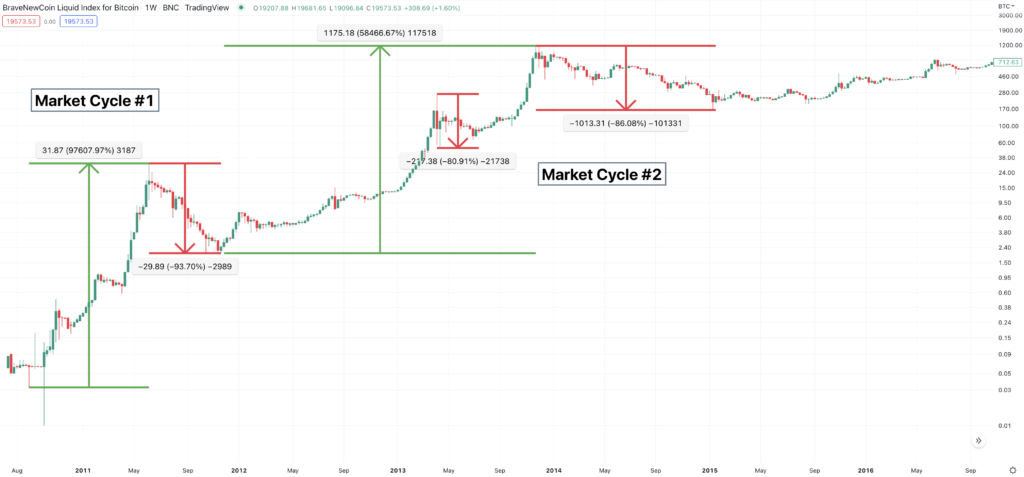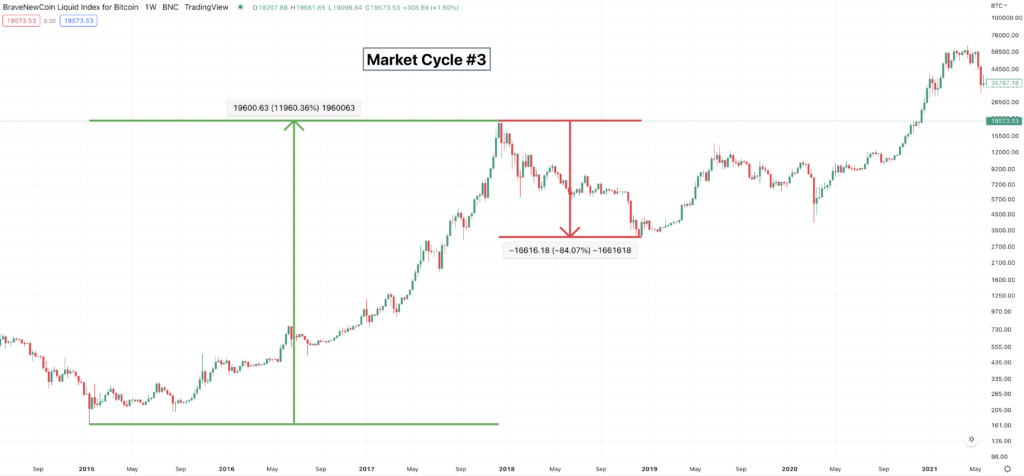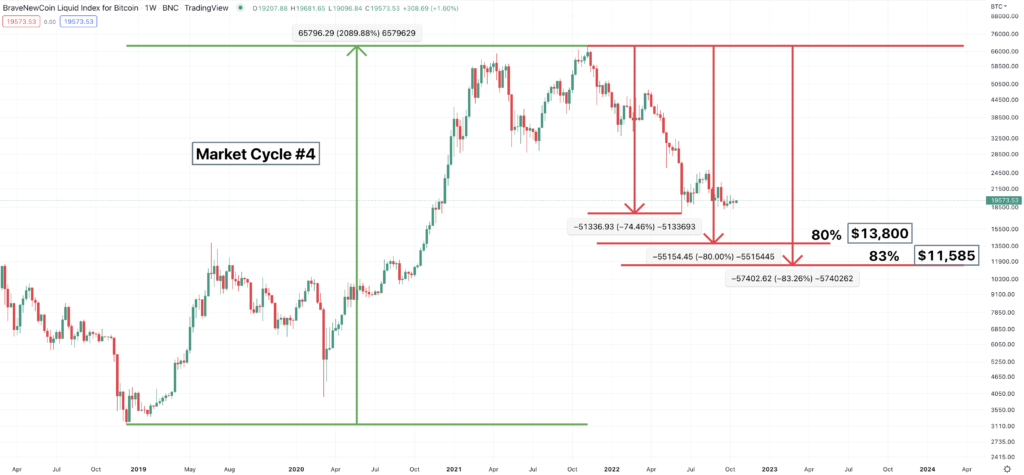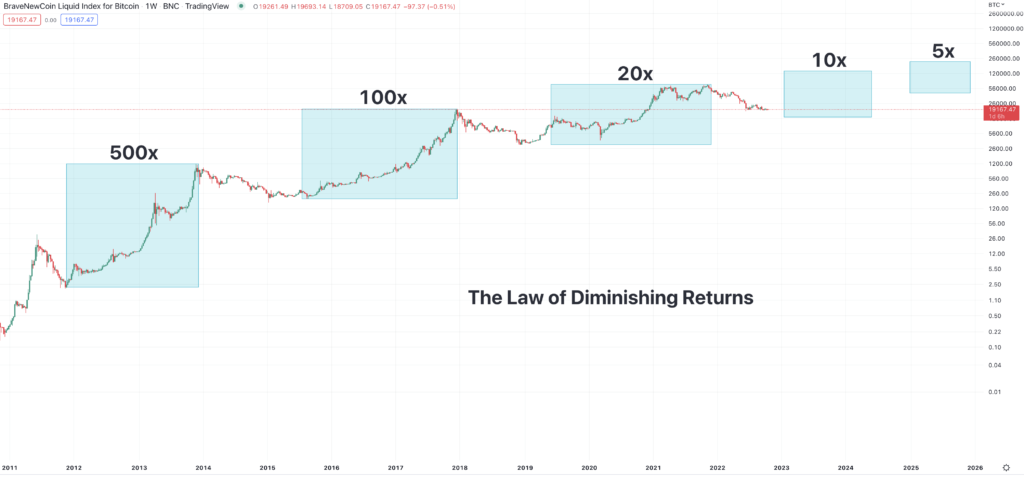Without this knowledge, it can be difficult for the average person to understand why investing in digital assets is an amazing long-term strategy.
Garnering a historical perspective and learning about these cycles is one of the keys to dismissing the idea that investing in crypto is too risky or like gambling. That very flawed and unfortunate idea comes from a lack of education and understanding how this market truly works. Some institutional investors have already figured this out, but unfortunately far too many investors have not been given the proper tools to understand this. At the end of this chapter and the following several chapters, you’ll be able to discern two undeniable truths:
- Investing in Bitcoin and other high-quality digital assets is an excellent long-term value strategy.
- The volatile and cyclical nature of this emerging asset class also makes it possible to supercharge profits by trading the longer-term market cycles.
Why is this so Important?
Less informed investors are like lost desert wanderers in the pitch black of night without this knowledge. Understanding how and why digital assets perform in these distinct cycles and what these cycles look like will build the necessary conviction you need for long-term success in this market.
Think of the companies that Warren Buffett invested in over the years that led to his tremendous wealth. These were all companies that he believed were excellent long-term values: Coca Cola, American Express, Apple, Bank of America, Chevron, Geico, etc. There was a point during many of these company’s lifecycles when the end looked near and failure seemed inevitable. Buffett was able to hold on to them over the years because of one simple investing thesis that he had the conviction to stick to: you create wealth by holding excellent value stocks over a long period of time.
To be excellent investors in anything, you have to fully understand what you’re investing in. If you don’t, it’s nearly impossible to create the Buffett-like conviction that’s necessary to be successful. To build this type of conviction in this market, we need to learn about crypto market cycles.
If you so choose to make it your investment strategy, this chapter will also open your eyes to the potency of trading crypto market cycles. The market cycle strategy takes advantage of the cycle-to-cycle volatility by following these fundamental steps:
- Accumulate as much Bitcoin and other quality digital assets during bear markets as humanly possible.
- Ride the explosive waves up during bull markets, and then take profits as the market gets overheated and buyers become exhausted.
- Do this so that you’re ready to reload during the next bear market with the goal of repeating this process and supercharging profits.
This sounds simple, doesn’t it? It can absolutely be done, but it takes specific knowledge, discipline, a lot of studying, and solid conviction. Executing this even fairly well can lead to unparalleled gains and, ultimately, generational wealth.
Why Do We Have a Better Chance at Playing Market Cycles in Crypto than in Stocks?
Doesn’t the data show us that trading is a fool’s game? For both the average investor and even the “pros,” it’s nearly impossible to beat the traditional stock market by trying to time when to get in and out. There’s so much data compiled by so many smart people to prove this point that it’s a pretty tough one to argue.
The stock market is mature and efficient today because of the total amount of money present as well as the level of sophisticated investors. This makes it extremely difficult if not impossible to consistently beat the market as a trader. The following excerpt from Jason Zweig’s commentary on The Intelligent Investor shows us how Benjamin Graham, considered the father of value investing and one of the most influential investors in history, explained this sentiment:
“In this section, Graham is summarizing the Efficient Market Hypothesis. Recent appearances to the contrary, the problem with the stock market today is not that so many financial analysts are idiots, but rather that so many of them are so smart. As more and more smart people search the market for bargains, that very act of searching makes those bargains rarer—and, in a cruel paradox, makes the analysts look as if they lack the intelligence to justify the search.”
Because the digital asset market is still so young, a crypto investor can generate wealth in two ways. The first is to simply buy and hold a digital asset like Bitcoin over a long time horizon. But the buy and hold motto of the stock market is not the only winning move in the digital asset market. Wealth can also be generated by learning the necessary skills to buy and sell the broader market cycles, capitalizing on the inefficiencies that still exist in this market.
Traditional Bull and Bear Markets in Stocks Versus Digital Assets
In the traditional stock market, a bull market is characterized by an extended trend of upward movement in stock prices, usually lasting at least several months and typically several years. A commonly accepted definition of a bull market is when stock prices rise at least 20% after a bear market and before the next bear market.
A bear market in stocks is typically defined as a 20% or more correction in asset prices. The average length of a bear market in equities is 9.5 months or 289 days. We could also define bear markets as a time when investors are more risk averse as opposed to taking on risk in bull markets. By the beard of Zeus, these definitions are quite a bit different in digital assets.
In crypto, it’s best to define a digital asset bull market as a multi-year upward explosion in prices that has historically led to new all-time highs in Bitcoin and total market cap for crypto. These bull markets have resumed each and every time following a bear market, or “crypto winter.”
A bear market in crypto is best defined as a period when historically there’s been an 80% or more correction in Bitcoin’s price. Prepare yourself, because there are usually at least a half-dozen “smaller” 20% or more corrections within a bull market in digital assets.
Market Cycle #1
In the good old days of cycle number one, Bitcoin had a crazy run up of about 100,000%, if we take the price of $.03 in 2010 until the peak of $31.90 in 2011.
What followed was about one year of horrifying price action as Bitcoin fell over 93% to $2.01. It’s important to note that the low of $2.01 was still significantly higher than the many months of previous price action. This will be a common theme as we go through these market cycle charts.
The duration of this bear market was approximately 322 days.
Market Cycle #2
Cycle number two was particularly interesting. There was an extremely strong mid-cycle correction of about 80% which only lasted 77 days before Bitcoin’s price ripped higher for the ultimate top. Bitcoin topped in this cycle at $1,177.19, which was about a 58,000% increase from the previous cycle bottom of $2.01.
This cycle’s correction saw a nail-biting 84% drop from top to bottom. Once again, look at how much higher the new bottom price of $163.88 is relative to the previous bottom of $2.01.
The duration of this bear market was approximately 616 days.

Market Cycle #3
In cycle number three, from the previous cycle bottom of $163.88, Bitcoin rallied over 10,000%, hitting a peak of nearly $20,000 at the end of 2017.
The following bear market saw a chilling 83% correction and lasted even longer than the previous cycle’s corrective period. For the third cycle in a row, Bitcoin’s new low of $3,148 was significantly higher than the previous cycle’s bottom of $163.88.
The duration of this bear market was approximately 861 days.

Market Cycle #4
This is our current cycle at the time of writing this book in 2022. From the previous bottom of $3,148, Bitcoin rallied over 2,000% to a new all-time high of $68,995.
We’ve currently seen a 74% reduction in price to $17,600. As you’ll see, I’ve noted that a more typical 80% correction would take us to around $13,800. An 83% correction (the % correction of the previous cycle) would bring us to approximately $11,585.
The duration of this current bear market is unknown, but I can say with strong confidence that the new low will once again be significantly higher than the previous cycle low of $3,148.

We can also theorize that as Bitcoin matures to a multi-trillion-dollar asset, each market cycle will experience less and less volatility. The gains will be less explosive. This is no different than a mature stock like Apple. It will now take exponentially longer to triple the market cap of Apple than it did 15 years ago. This is common sense, right? Apple was much more volatile in its early days because it was less proven and there was much less money invested into it. We’ve already seen that same logical progression in Bitcoin as an asset. Market Cycle #3 experienced roughly a 100x from the previous cycle bottom to the new top compared to a more moderate 20x in our latest market cycle. We can extrapolate that Market Cycle #5 might experience roughly a 10x from bottom to top (approximately a $150,000 top in 2025). Market Cycle #6 might experience a 5x from the next bottom to the new top. And so forth.

This trajectory would be a prime example of the law of diminishing returns, which the Oxford dictionary defines as “a principle stating that profits or benefits gained from something will represent a proportionally smaller gain as more money or energy is invested in it.”
That concludes this important post on understanding digital asset market cycles. As you learned, the data is clear that Bitcoin continues to make higher highs and higher lows each and every market cycle. The volatility is not something to be feared once you understand how this market ebbs and flows.
If you enjoyed this post, The Modern Investor, which is now out on Amazon, goes into MUCH more detail on market cycles. This post only scratched the surface of the book’s content. In the next post, we’ll go over some of the best free tools and resources to utilize on your investing journey.
Thanks for reading! If you enjoyed this, check out the other articles and don’t forget to follow me on Twitter @andrewdfarrar for up-to-date crypto content. In these crazy times, it’s never been a more important time to learn about this new asset class.

